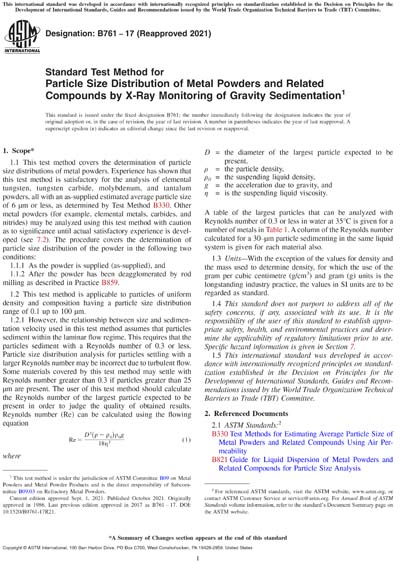Most recent
ASTM B761-17(2021)
Standard Test Method for Particle Size Distribution of Metal Powders and Related Compounds by X-Ray Monitoring of Gravity Sedimentation
1.1This test method covers the determination of particle size distributions of metal powders. Experience has shown that this test method is satisfactory for the analysis of elemental tungsten, tungsten carbide, molybdenum, and tantalum powders, all with an as-supplied estimated average particle size of 6 μm or less, as determined by Test Method B330. Other metal powders (for example, elemental metals, carbides, and nitrides) may be analyzed using this test method with caution as to significance until actual satisfactory experience is developed (see 7.2). The procedure covers the determination of particle size distribution of the powder in the following two conditions:
1.1.1As the powder is supplied (as-supplied), and
1.1.2After the powder has been deagglomerated by rod milling as described in Practice B859.
1.2This test method is applicable to particles of uniform density and composition having a particle size distribution range of 0.1 up to 100 μm.
1.2.1However, the relationship between size and sedimentation velocity used in this test method assumes that particles sediment within the laminar flow regime. This requires that the particles sediment with a Reynolds number of 0.3 or less. Particle size distribution analysis for particles settling with a larger Reynolds number may be incorrect due to turbulent flow. Some materials covered by this test method may settle with Reynolds number greater than 0.3 if particles greater than 25 μm are present. The user of this test method should calculate the Reynolds number of the largest particle expected to be present in order to judge the quality of obtained results. Reynolds number (Re) can be calculated using the flowing equation

A table of the largest particles that can be analyzed with Reynolds number of 0.3 or less in water at 35°C is given for a number of metals in Table 1. A column of the Reynolds number calculated for a 30"“μm particle sedimenting in the same liquid system is given for each material also.
1.3Units - With the exception of the values for density and the mass used to determine density, for which the use of the gram per cubic centimetre (g/cm3) and gram (g) units is the longstanding industry practice, the values in SI units are to be regarded as standard.
1.4This standard does not purport to address all of the safety concerns, if any, associated with its use. It is the responsibility of the user of this standard to establish appropriate safety, health, and environmental practices and determine the applicability of regulatory limitations prior to use. Specific hazard information is given in Section 7.
1.5This international standard was developed in accordance with internationally recognized principles on standardization established in the Decision on Principles for the Development of International Standards, Guides and Recommendations issued by the World Trade Organization Technical Barriers to Trade (TBT) Committee.
Content Provider
ASTM International [astm]






